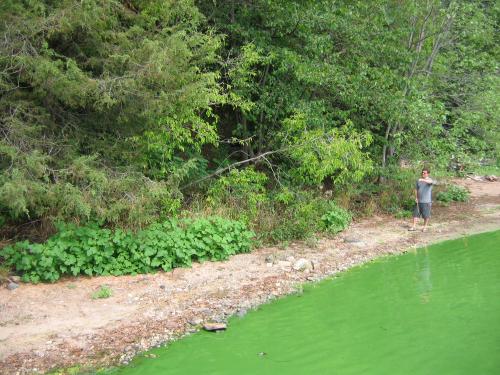Why is my lake turning colors?
Harmful algal blooms (HABs) can pose risk to people and pets. Learn to recognize HABs when recreating on Michigan inland lakes.
Most lakes and ponds support planktonic algae – the tiny, single-celled plants that float in the water column and form the base of the lake food web. They occur naturally and can grow rapidly with increasing water temperatures, lots of sunlight and excess nutrients such as phosphorus and nitrogen, entering the lake from lawns and other sources. A recent Michigan State University Extension article explains how rooted aquatic plant control efforts may also contribute to algae growth in shallow lakes.

Photo: A harmful algal bloom (HAB) along an inland lake shoreline.
Green planktonic algae are true plants and are fed upon by fish and other aquatic animals. But blue-green algae are technically not algae. They are cyanobacteria that possess chlorophyll and photosynthesize like plants. When either kind of algae multiplies so rapidly that they can be seen with the naked eye it is called an algal bloom. Most green algal blooms are harmless, but a bloom of cyanobacteria is referred to as a harmful algal bloom (HAB) and should be avoided. This is because, in high concentrations, cyanobacteria can produce toxins that can pose health risks to people and pets.
The toxic nature of cyanobacteria results in little or no control by fish and other animals. Because of this and other factors, blue-green algae often outcompete green algae for nutrients in the water column. They multiply rapidly (bloom) in both the shallow, quiet, sunny parts of the lake and in open water.
According to Michigan Sea Grant, “Blooms can range in color from red to bright, neon green to more blue-green. A bloom can look like a scum, foam or mat on top of the water or like paint that has been spilled in the water. They are also sometimes accompanied by an earthy, pungent or musty smell. However, not all algal blooms give off an odor or affect the appearance water and toxins can remain present in the water even when a bloom has dissipated.”
A bloom of cyanobacteria can produce neurotoxins, liver toxins, cell toxins and skin irritants in concentrations that may be harmful. One of the most commonly occurring cyanobacteria in the Great Lakes region is Microsystis which can produce a liver toxin known as Microsystin. People and pets that consume large amounts of Microsystin, or other toxins produced by HABs, may experience an array of symptoms from muscle cramps, nausea and vomiting to paralysis, cardiac or respiratory difficulty, and even liver failure. Skin irritants, found in nearly all blue-green algae blooms, can produce rashes and gastrointestinal distress.
HABs may persist for a day or two up to several weeks, depending on lake conditions. It is important for those who recreate on Michigan’s inland lakes to learn to recognize HABs and avoid contact. HABs are also a concern in farm ponds used for swimming or livestock watering. To learn more about HABs and how to recognize them, visit Michigan Sea Grant.



 Print
Print Email
Email

